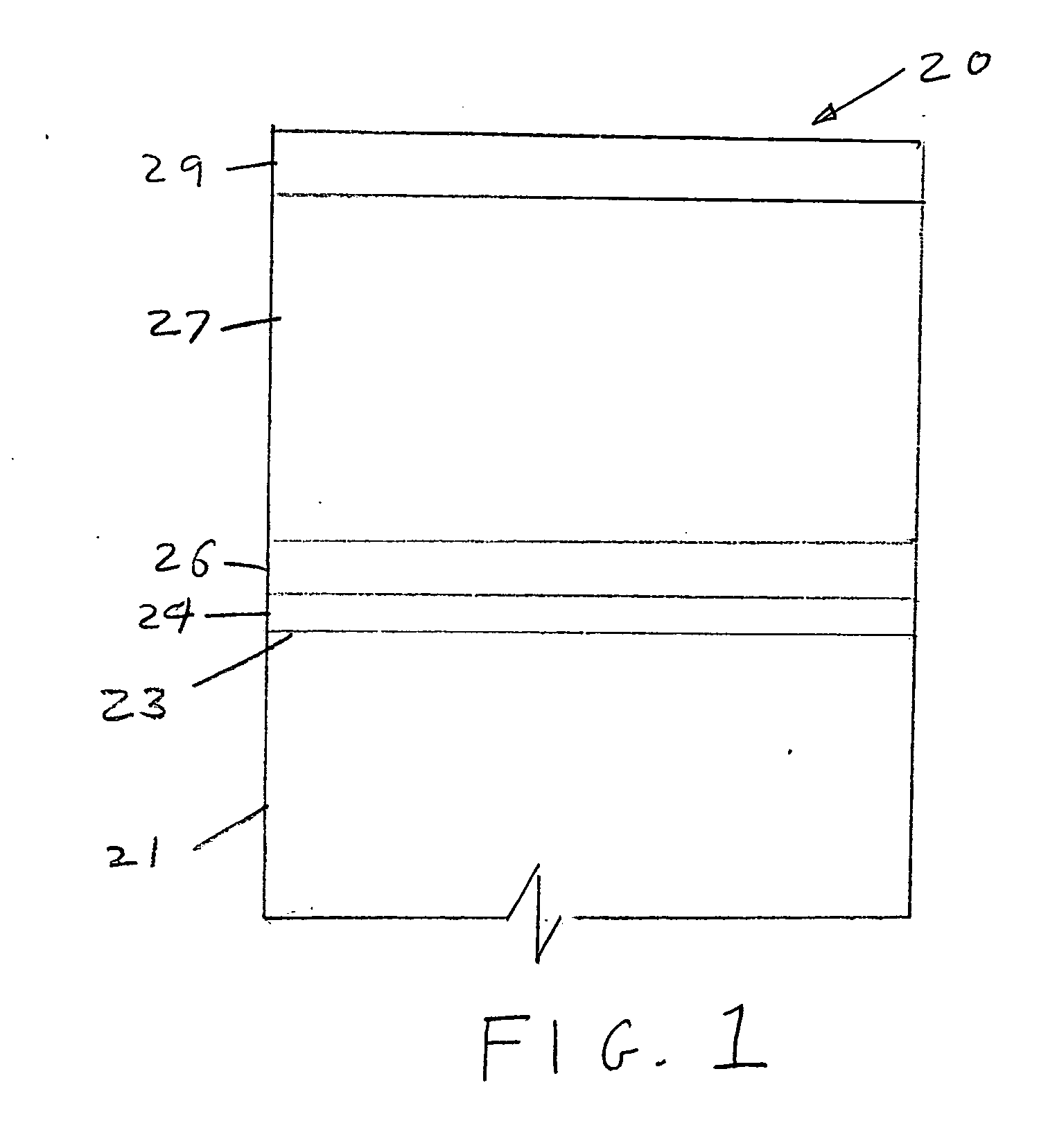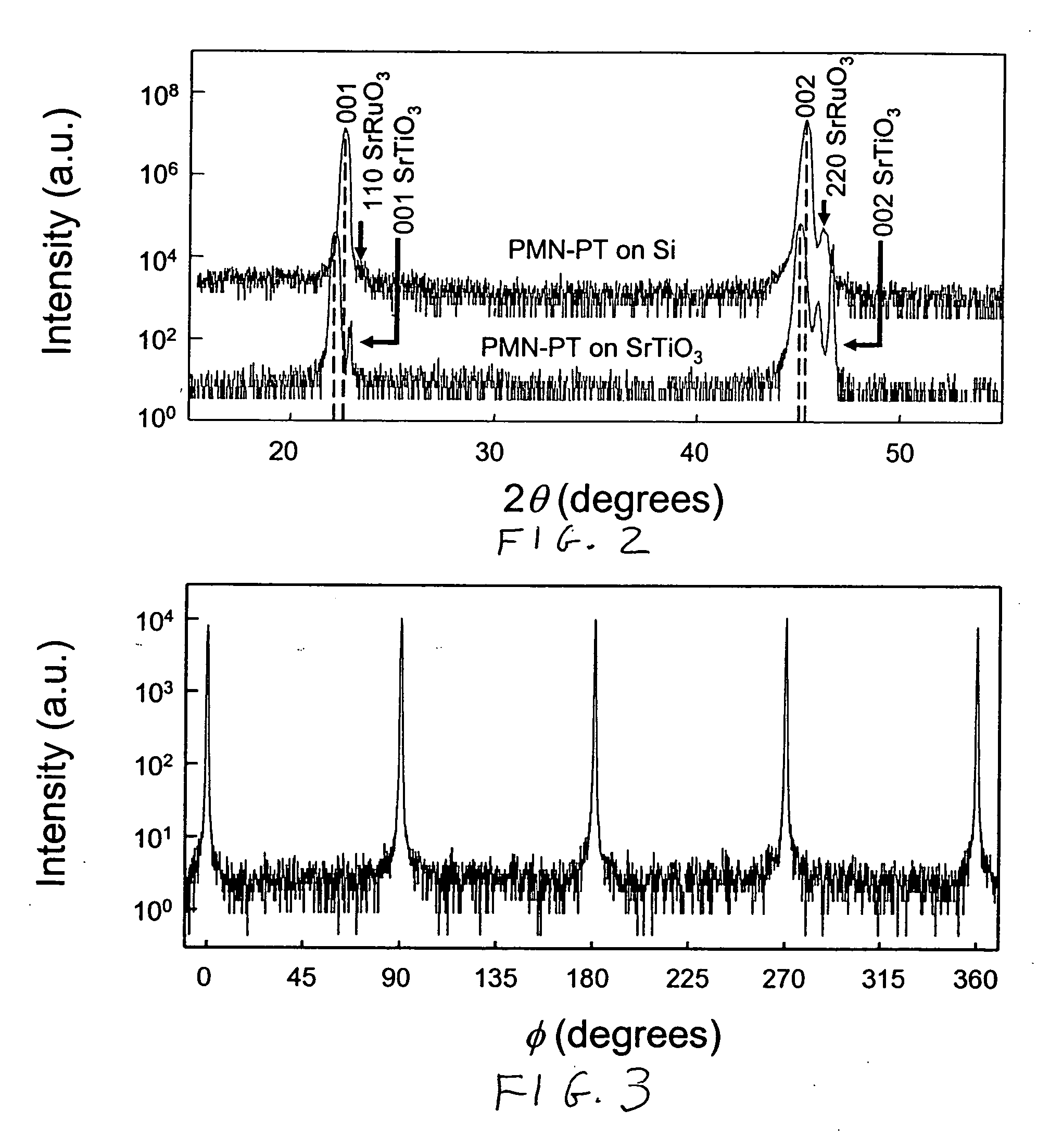Perovskite-based thin film structures on miscut semiconductor substrates
a technology of semiconductor substrates and thin films, applied in the field of semiconductors, can solve the problems of significantly reducing piezoelectric qualities of piezoelectric crystalline materials grown on semiconductor substrates such as silicon, and achieve the effects of high saturation strain, high quality epitaxial heterostructures, and good metallic behavior
- Summary
- Abstract
- Description
- Claims
- Application Information
AI Technical Summary
Benefits of technology
Problems solved by technology
Method used
Image
Examples
example 1
Fabrication of a PMN-PT-Based Piezoelectric Thin Film Structure
[0029] An example of a preferred substrate 21 that may be utilized in the invention is a (001) Si wafer coated with a seed layer 24 of SrTiO3. The epitaxial SrTiO3 layer 24 may be deposited by reactive molecular beam epitaxy (MBE) or other suitable processes. A suitable process is described in J. Lettieri, “Critical Issues of Complex, Epitaxial Oxide Growth and Integration with Silicon by Molecular Beam Epitaxy,” Ph.D. Thesis (Pennsylvania State University, 2002), available on-line at http: / / etda.libraries.psu.edu / theses / approved / WorldWidelndex / ETD-202 / index.html. The top surface 23 of the (001) Si wafer 21 is preferably miscut by 1° to 20°, most preferably 4°, toward (110) to improve the epitaxy of PMN-PT thick films and suppress pyrochlore phase formation. A 100 nm thick conducting SrRuO3 bottom electrode 26 is then deposited at a substrate temperature of 600° C. by 90° off-axis radio-frequency (RF) magnetron sputteri...
example 2
Fabrication of a PZT-Based Piezoelectric Thin Film Structure
[0037] High quality epitaxial PZT thick films up to 4 μm were fabricated on both (001) SrTiO3 and 4 degree miscut (001) Si substrates. Epitaxial (001) PZT films with various thicknesses (0.4-41 μm) were grown on (001) SrTiO3 and 4 degree miscut (001) Si substrates using on-axis radio-frequency (RF) magnetron sputtering. The nominal composition of the sputtering target was PZT (Zr / Ti=52 / 48). Molecular-Beam-Epitaxy (MBE) was used to fabricate 100 Å of epitaxial (001) SrTiO3 on the Si substrate as a seed layer in order to grow epitaxial PZT films. MBE methods of growing SrTiO3 layers are described in, G. Y. Yang, J. M. Finder, J. Wang, Z. L. Wang, Z. Yu, J. Ramdani, R. Droopad, K. W. Eisenbeiser, and R. Ramesh, J. Mater. Res. 17, 204 (2002), the entire disclosure of which is incorporated herein by reference. Prior to the PZT film deposition, an epitaxial SrRuO3 bottom electrode was deposited by 90° off-axis RF magnetron sputt...
example 3
Fabrication of a BiFeO3-Based Piezoelectric Thin Film Structure
[0041] A four layer structure including a 4 degree miscut Si substrate, a SrTiO3 seed layer, a first overlayer composed of SrRuO3 (100 nm thick) and a second overlayer composed of BiFeO3 was fabricated. The SrTiO3 seed layer and the SrRuO3 overlayer were grown on the Si substrate using the same methods described in Example 1, above. A 600 nm thick BiFeO3 film was then deposited by on-axis RF-magnetron sputtering from a stoichiometric sintered target. During BiFeO3 film deposition, the substrate temperature is maintained at 690° C. with argon and oxygen partial pressures of 240 mTorr and 160 mTorr, respectively.
PUM
| Property | Measurement | Unit |
|---|---|---|
| Thickness | aaaaa | aaaaa |
| Thickness | aaaaa | aaaaa |
| Thickness | aaaaa | aaaaa |
Abstract
Description
Claims
Application Information
 Login to View More
Login to View More - R&D
- Intellectual Property
- Life Sciences
- Materials
- Tech Scout
- Unparalleled Data Quality
- Higher Quality Content
- 60% Fewer Hallucinations
Browse by: Latest US Patents, China's latest patents, Technical Efficacy Thesaurus, Application Domain, Technology Topic, Popular Technical Reports.
© 2025 PatSnap. All rights reserved.Legal|Privacy policy|Modern Slavery Act Transparency Statement|Sitemap|About US| Contact US: help@patsnap.com



